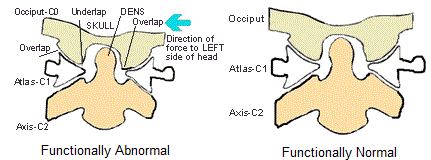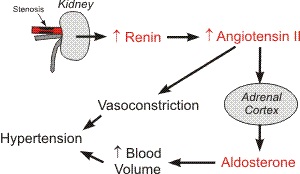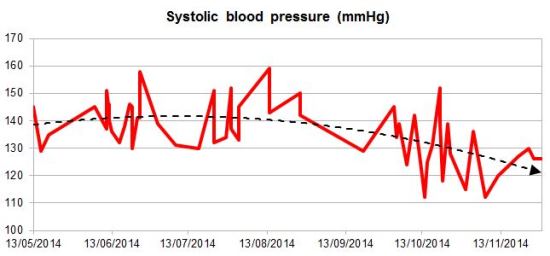

The following is a case study of reduction in primary hypertension in a 35-year old male following upper cervical chiropractic care with no other influencing factors.
A study in the Journal of Human Hypertension examined the effects of an atlas adjustment on blood pressure. Results showed that restoration of atlas alignment was associated with marked and sustained reductions in blood pressure, similar to the use of two-drug combination therapy1.
It was postulated that alterations in atlas anatomy can generate changes in the vertebral circulation that may be associated with high blood pressure.
Unlike other vertebrae, which interlock one to the next, the atlas relies solely upon soft tissue (muscles and ligaments) to maintain alignment. The atlas is therefore uniquely vulnerable to displacement. Displacement of C1 is pain free and thus remains undiagnosed and untreated (below) whereas other health-related consequences can be attributed to specific causes1.

Secondary hypertension has an identifiable cause, such as renovascular disease, whereas primary hypertension has no known cause. Primary hypertension accounts for 95% of all cases of high blood pressure2 and in recent years research has suggested that changes in endothelial (blood vessel wall) function may cause an increase in blood vessel tone due to oxidative stress, insulin resistance, inflammation, and poor nervous system function resulting in increased levels of angiotensin II (below).

All patients with high blood pressure should be questioned about a history of trauma, especially whiplash from a motor vehicle accident, contact sports injury, or serious falls. People often forget these accidents, thinking that they were not hurt because they did not break any bones and were not bleeding.
Minor misalignment of the atlas vertebra can potentially injure and/or compromise brainstem neural pathways resulting in changes in blood pressure1 ?
A 35-year old male presented with an average blood pressure of 142mmHg from May to October 2014. Upper cervical chiropractic care commenced on October 10, 2014. Following consistent chiropractic care over a 3-month period, the patient’s blood pressure reduced to an average of 126mmHg from October to December 2014 (see graph below).
This result is consistent with the results of the study mentioned above. No other medical treatment or intervention was utilised at any time. All blood pressure recordings were taken daily by the patient electronically.
Hypertension can be a multifactorial problem and any treatment provided should always be done so in the context of the patient’s presenting health problems and lifestyle issues. In this case study, upper cervical chiropractic care alone was able to alter neurovascular tone sufficiently to lower the patient’s blood pressure. Results have been maintained through to 2015.

© 2015 Spinewave
Further reading:
- New blood pressure guidelines 2014
- High blood pressure special chiropractic report
- High blood pressure damages the brain
References:
- Bakris, G, et al. Atlas vertebra realignment and achievement of arterial pressure goal in hypertensive patients: a pilot study. Journal of Human Hypertension. 2007. 21(5): 347-52.
- Carretero, OA, et al. Essential hypertension. Circulation. 2000. 101: 329-335.
